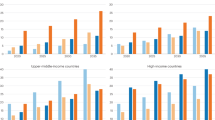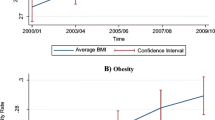Abstract
There is a consensus that places obesity as a main public health problem of the twenty-first century. Most of the epidemiological research in this field has focused on the role of individual factors linked to lifestyles such as diet and physical activity. However, since the emergence of the notion of obesogenic environments and the consolidation of the social determinants of health approach, the influence of contextual factors (physical, socioeconomic, cultural, and political) has become a crucial topic to better understand and address the obesity epidemic. In Argentina, one third of the adult population had obesity in 2018, with an overall rising trend in the last years. There is evidence suggesting that obesity follows a social gradient in this country: its prevalence decreases with an increase in the socio-economic level. This chapter analyzes and illustrates by maps the distribution of obesity prevalence among specific social groups. Our purpose was to study the territorial patterns of social inequity in the health and nutrition of the Argentine population, particularly considering geographical differentials in obesity burden according to sex, age, and socio-economic conditions. Public databases such as the 2005, 2009, and 2013 editions of the National Survey of Risk Factors (National Health Ministry) were used. First, the chapter introduces the notion of obesity as a complex multicausal pathology and highlights the importance of having a broader view of the socio-environmental determinants of the obesity epidemic. Second, we provide and interpret thematic maps for 2005, 2009, and 2013 that represent the spatio-temporal distributions of the age-standardized obesity rate by sexes, and the specific prevalences by age groups (young, middle-aged, and older adults), education level (population with complete university studies versus without complete primary education), and poverty (population with or without unsatisfied basic needs). Finally, the chapter discusses the role of public policies in the last years in Argentina and the challenges to address the ongoing obesity epidemic within the context of an intersectoral work.
Access this chapter
Tax calculation will be finalised at checkout
Purchases are for personal use only
Similar content being viewed by others
References
Aballay LR, Osella AR, Celi A, Díaz MDP (2009) Overweight and obesity: prevalence and their association with some social characteristics in a random sample population-based study in Córdoba city, Argentina. Obes Res Clin Pract 3: I-II. https://doi.org/10.1016/j.orcp.2009.01.001
Aballay LR, Osella AR, De La Quintana AG, Díaz MDP (2016) Nutritional profile and obesity: results from a random-sample population-based study in Córdoba, Argentina. Eur J Nutr 55:675–685. https://doi.org/10.1007/s00394-015-0887-0
Aguirre P (2000) Aspectos socioantropológicos de la obesidad en la pobreza. In: Peña M, Bacallao J (eds) La Obesidad en la Pobreza. Publicación Científica No 576, Washington, OPS
Bautista LE, Casas JP, Herrera VM, Miranda JJ, Perel P, Pichardo R, González A, Sanchez JR, Ferreccio C, Aguilera X, Silva E, Oróstegui M, Gómez LF, Chirinos JA, Medina-Lezama J, Pérez CM, Suárez E, Ortiz AP, Rosero L, Schapochnik N, Ortiz Z, Ferrante D (2009) The Latin American consortium of dtudies in Obesity (LASO) Obes Rev 10:364–370. https://doi.org/10.1111/j.1467-789X.2009.00591.x
Ben-Shlomo Y, Kuh D (2002) A life course approach to chronic disease epidemiology: conceptual models, empirical challenges and interdisciplinary perspectives. Int J Epidemiol 31(2):285–293
Chooi YC, Ding C, Magkos F (2019) The epidemiology of obesity. Metabolism 92:6–10. https://doi.org/10.1016/j.metabol.2018.09.005
Cockerham WC, Hamby BW, Oates GR (2017) The social determinants of chronic disease. Am J Prev Med 52:S5–S12. https://doi.org/10.1016/j.amepre.2016.09.010
Comisión Económica para América Latina y el Caribe (CEPAL) 2016. La matriz de la desigualdad social en América Latina. Naciones Unidas, CEPAL, Santiago, 96 p
Custodio J, Elizathe L, Murawski B, Rutsztein G (2015) Obesidad en Argentina: un desafío pendiente. Políticas de salud pública y tasas de prevalencia. Revista Mexicana De Trastornos Alimentarios 6:137–142
Elgart J, Pfirter G, González L, Caporale J, Cormillot A, Chiappe ML et al (2010) Obesidad en Argentina: Epidemiología, morbimortalidad e impacto económico. Rev Argent Salud Pública 1(5):6–12
Figueroa Pedraza D (2009) Obesidad y Pobreza: marco conceptual para su análisis en latinoamérica. Saúde E Soc 18(1):103–117
Finucane MM, Stevens GA, Cowan MJ, Danaei G, Lin JK, Paciorek CJ, Singh GM, Gutierrez HR, Lu Y, Bahalim AN, Farzadfar F, Riley LM, Ezzati M (2011) Global burden of metabolic risk factors of chronic diseases collaborating group (Body Mass Index) National, regional, and global trends in body-mass index since 1980: systematic analysis of health examination surveys and epidemiological studies with 960 country-years and 9·1 million participants. Lancet 377(9765):557–567.https://doi.org/10.1016/S0140-6736(10)62037-5
Ford ND, Patel SA, Narayan KM (2017) Obesity in low- and middle-income countries: burden, drivers, and emerging challenges. Annu Rev Public Health 38:145–164. https://doi.org/10.1146/annurev-publhealth-031816-044604
Instituto Nacional de Estadísticas y Censos (INDEC) (2019) Necesidades básicas insatisfechas. https://sitioanterior.indec.gob.ar/nivel4_default.asp?id_tema_1=4&id_tema_2=27&id_tema_3=66
Kirk SFL, Penney TL, McHugh T-LF (2010) Characterizing the obesogenic environment: the state of the evidence with directions for future research. Obes Rev 11(2):109–117
Krieger N (2001) A glossary for social epidemiology. J Epidemiol Commun Health 55(10):693–700
Linetzky B, De Maio F, Ferrante D, Konfino J, Boissonnet C (2013) Sex-stratified socio-economic gradients in physical inactivity, obesity, and diabetes: evidence of short-term changes in Argentina. Int J Public Health 58:277–284. https://doi.org/10.1007/s00038-012-0371-z
Mahmudiono T, Segalita C, Rosenkranz RR (2019) Socio-ecological model of correlates of double burden of malnutrition in developing countries: a narrative review. Int J Environ Res Public Health 16(19):pii: E3730. https://doi.org/10.3390/ijerph16193730.
Michou M, Panagiotakos DB, Costarelli V (2018) Low health literacy and excess body weight: a systematic review. Cent Eur J Public Health 26:234–241. https://doi.org/10.21101/cejph.a5172
Ministerio de Salud de la Nación (2007) Encuesta Nacional de Nutrición y Salud. Documento de Resultados 2007. Buenos Aires: Ministerio de Salud de la Nación Argentina
McKeown RE (2009) The epidemiologic transition: changing patterns of mortality and population dynamics. Am J Lifestyle Med 3:19S–26S
Ministerio de Salud e Instituto Nacional de Estadísticas y Censos (INDEC) (2005) Encuesta Nacional de Factores de Riesgo (ENFR) 2005. https://www.indec.gob.ar/indec/web/Institucional-Indec-BasesDeDatos-2
Ministerio de Salud e Instituto Nacional de Estadísticas y Censos (INDEC) (2009) Encuesta Nacional de Factores de Riesgo (ENFR) 2009. https://www.indec.gob.ar/indec/web/Institucional-Indec-BasesDeDatos-2
Ministerio de Salud e Instituto Nacional de Estadísticas y Censos (INDEC) (2013) Encuesta Nacional de Factores de Riesgo (ENFR) 2013. https://www.indec.gob.ar/indec/web/Institucional-Indec-BasesDeDatos-2
Ministerio de Salud y Desarrollo Social de la Nación (2019) 4ta. Encuesta Nacional de Factores de Riesgo. Informe definitivo. Buenos Aires: Dirección Nacional de Promoción de la Salud y Control de Enfermedades Crónicas No Transmisibles, 262 p
NCD Countdown 2030 collaborators (2018) NCD Countdown 2030: worldwide trends in non-communicable disease mortality and progress towards Sustainable Development Goal target 3.4. Lancet 392(10152):1072–1088. https://doi.org/10.1016/S0140-6736(18)31992-5
NCD Risk Factor Collaboration (NCD-RisC) (2017) Worldwide trends in body-mass index, underweight, overweight, and obesity from 1975 to 2016: a pooled analysis of 2416 population-based measurement studies in 128·9 million children, adolescents, and adults.Lancet 390(10113):2627–2642.https://doi.org/10.1016/S0140-6736(17)32129-3
Ng M, Fleming T, Robinson M, Thomson B, Graetz N, Margono C, Mullany EC, Biryukov S, Abbafati C, Abera SF, Abraham JP, Abu-Rmeileh NM, Achoki T, AlBuhairan FS, Alemu ZA, Alfonso R, Ali MK, Ali R, Guzman NA, Ammar W, Gakidou E (2014) Global, regional, and national prevalence of overweight and obesity in children and adults during 1980–2013: a systematic analysis for the Global Burden of Disease Study 2013. Lancet 384:766–781. https://doi.org/10.1016/S0140-6736(14)60460-8
Omran AR (1971) The epidemiologic transition. A theory of the epidemiology of population change. Milbank Mem Fund Q 49(4):509–538
Organización Panamericana de la Salud (OPS-PAHO) (2018) Perfil de capacidad y respuesta frente a las enfermedades no transmisibles y sus factores de riesgo en la Región de las Américas. Resultados de la encuesta de Perfil de Capacidad. Washington, D.C.: OPS-OMS. Organización Panamericana de la Salud (OPS-PAHO), Organización Mundial de la Salud (OMS-WHO) 2018. Enfermedades No Transmisibles: Perfiles de países, 2018. https://www.who.int/nmh/countries/es/
Peña M, Bacallao J (eds) (2000) La Obesidad en la Pobreza. Un nuevo reto para la salud pública. Publicación Científica No 576. OPS, Washington, DC, 132 p
Pollard TM (2008) Western diseases. An evolutionary perspective. Cambridge University Press, New York
Popkin BM, Adair LS, Ng SW (2012) Global nutrition transition and the pandemic of obesity in developing countries. Nutr Rev 70(1):3–21. https://doi.org/10.1111/j.1753-4887.2011.00456.x
Popkin BM, Reardon T (2018) Obesity and the food system transformation in Latin America. Obes Rev 19(8):1028–1064. https://doi.org/10.1111/obr.12694
Popkin BM, Slining MM (2013) New dynamics in global obesity facing low- and middle-income countries: new global obesity dynamics, body composition changes. Obes Rev 14:11–20
Pou SA, Díaz MDP, De La Quintana AG, Forte CA, Aballay LR (2016) Identification of dietary patterns in the urban population of Argentina: study on diet-obesity relation in population-based prevalence study. Nutr Res Pract 10:616–622. https://doi.org/10.4162/nrp.2016.10.6.616
Pou SA, Díaz MDP, Velázquez GA (2018) Socio-environmental patterns associated with cancer mortality: a study based on a quality of life approach. Asian Pac J Cancer Prev 19(11):3045–3052
Pou SA, Diaz MP, Velázquez GA, Aballay LR (2021) Sociodemographic disparities and contextual factors in obesity: updated evidence from a National Survey of Risk Factors for Chronic Diseases. Public Health Nutrition. 1–13. https://doi.org/10.1017/S1368980021004924
Pou SA, Tumas N, Sánchez Soria D, Ortiz P, Díaz MDP (2017) Large-scale societal factors and noncommunicable diseases: urbanization, poverty and mortality spatial patterns in Argentina. Appl Geogr 86:32–40. https://doi.org/10.1016/j.apgeog.2017.06.022
Solar O, Irwin A (2010) A conceptual framework for action on the social determinants of health. Social Determinants of Health Discussion Paper 2 (Policy and Practice). World Health Organization, Geneva
Spinelli H (2016) Volver a pensar en salud: programas y territorios. Salud Colectiva 12(2):149–171
Stunkard AJ (2000) Factores determinantes de la obesidad: opinión actual. In: Peña M, Bacallao J (eds) La Obesidad en la Pobreza. Publicación Científica No 576. OPS, Washington
Swinburn B, Egger G, Raza F (1999) Dissecting obesogenic environments: the development and application of a framework for identifying and prioritizing environmental interventions for obesity. Prev Med 29(6):563–570
Taylor MM (2018) The obesity epidemic. Why a social justice perspective matters. Palgrave Pivot, Switzerland, 86 p
Townshend T, Lake A (2017) Obesogenic environments: current evidence of the built and food environments. Perspect Public Health 137:38–44. https://doi.org/10.1177/1757913916679860
Tumas N, Rodríguez Junyent C, Aballay LR, Scruzzi GF, Pou SA (2019) Nutrition transition profiles and obesity burden in Argentina. Public Health Nutr 22(12):2237–2247. https://doi.org/10.1017/S1368980019000429
Velázquez GA (2008) Geografía y Bienestar. Situación local, regional y global de la Argentina luego del Censo de 2001. Buenos Aires: Eudeba
Velázquez GA (2011) Ranking del Bienestar según categorías urbanas en la Argentina (2001). Revista Geográfica De América Central 46:185–210
Velázquez GA (2013) Calidad de vida: El caso de Argentina. In: Garrocho C, Buzai G Geografía Aplicada en Iberoamérica: avances, retos y perspectivas. Toluca, El Colegio Mexiquense, 29 p
Velázquez GA (2016) A new index for study quality of life: combining socioeconomic and environmental indicators. In: Tonon G (ed) Indicators of quality of life in Latin America. Springer International Research, London, pp 57–77
Vlismas K, Stavrinos V, Panagiotakos DB (2009) Socio-economic status, dietary habits and health-related outcomes in various parts of the world: a review. Cent Eur J Public Health 17:55–63
World Health Organization (WHO) (2000) The implications for training of embracing: a life course approach to health. WHO, Ginebra
World Health Organization (WHO) (2020a). Obesity and overweight. https://www.who.int/news-room/fact-sheets/detail/obesity-and-overweight
World Health Organization (WHO) (2020b) Obesity. https://www.who.int/news-room/facts-in-pictures/detail/6-facts-on-obesity
World Health Organization (WHO) (2021) Obesity. https://www.who.int/health-topics/obesity#tab=tab_1
World Health Organization (WHO) (2018). Noncommunicable diseases Argentina 2018 country profile. https://www.who.int/publications/m/item/noncommunicable-diseases-arg-country-profile-2018
Zapata ME, Rovirosa A, Carmuega E (2016) La mesa argentina en las últimas dos décadas. Cambios en el patrón de consumo de alimentos y nutrientes (1996–2013). Ciudad Autónoma de Buenos Aires: Centro de Estudios sobre Nutrición Infantil (CESNI)
Author information
Authors and Affiliations
Corresponding author
Editor information
Editors and Affiliations
Rights and permissions
Copyright information
© 2022 The Author(s), under exclusive license to Springer Nature Switzerland AG
About this chapter
Cite this chapter
Pou, S.A., Aballay, L.R., Huergo, J. (2022). Socio Demography of Obesity in Argentina at the Beginning of the Twenty-First Century. In: Celemin, J.P., Velázquez, G. (eds) Inequities and Quality of Life in Argentina. The Latin American Studies Book Series. Springer, Cham. https://doi.org/10.1007/978-3-030-94411-7_6
Download citation
DOI: https://doi.org/10.1007/978-3-030-94411-7_6
Published:
Publisher Name: Springer, Cham
Print ISBN: 978-3-030-94410-0
Online ISBN: 978-3-030-94411-7
eBook Packages: Social SciencesSocial Sciences (R0)




